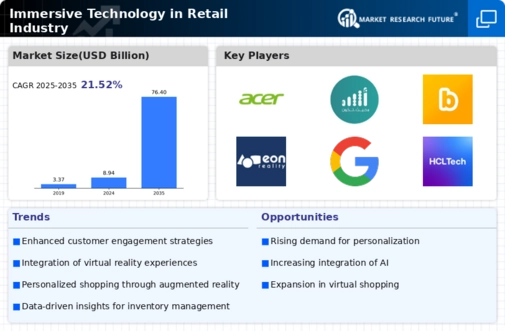Market Trends
Key Emerging Trends in the Immersive Technology in Retail Industry Market
The market for Immersive Technology in Retail is growing rapidly with more retailers realizing the potential of immersive technologies such as virtual reality (VR), augmented reality (AR) and mixed reality (MR) to enhance the shopping experience. Retailers in the Immersive Technology in Retail market employ various Market Share Positioning Strategies depending on their strategies to differentiate themselves and gain a competitive advantage. By taking advantage of immersive technologies, retailers can formulate touching and unique shopping experiences for their clientele. For instance, VR may be utilized by retailers to create virtual store environments, where customers can explore and interact with products before they make purchase choices in a virtual space. Virtual try-on and visualization is another significant strategy in the Immersive Technology in Retail market. Using AR and VR technologies, retailers can enable customers to virtually try on clothing, accessories or even furniture items within a digital space. This helps clients to preview how products will appear like or fit them prior to making purchases. Offering virtual try-on experiences helps to reduce physical try-ons resulting into faster buying process and greater customer satisfaction. This approach is most useful in fashion & beauty industries where buyers have an opportunity to test various styles or experiment with makeup looks. By positioning themselves as convenient vendors who provide accurate VR experiences which are convenient for trying items online; this attracts purchasers that value sound decision-making ability. Customization and personalization are other critical success factors for any organization intending to gain more market share through Immersive Technology in Retail (ITR). This enhances the ability of ITR users such as firms to offer individualized experiences reflecting upon their singular demands plus preferences by using these immersive systems. Personalized goods recommendations can also be provided by AR based systems considering buyer profiles along with previous transactions thus aiding buyers during decision making processes regarding suitable suitable options available through this channel of sales promotion. Custom built showrooms on-site or custom relatable events presented via VR might be a way of showing high levels of differentiation from competitors. The sense of exclusivity is one of the potential competitive advantages that can be created by offering personalized immersive experiences. Those who value customization may be drawn to these retailers if they position themselves as reliable sources of custom and tailored virtual reality shopping. Besides, market share positioning in ITR cannot be done without personalization and customization. Immersive technologies allow retailers to deliver tailored brand experiences for individual customers’ needs including their likes. One example could be AR being utilized by retailers to offer customers recommendations based on their preferences and buying history. VR can also create customized showrooms or shopping settings that cater to different types of buyers.













Leave a Comment